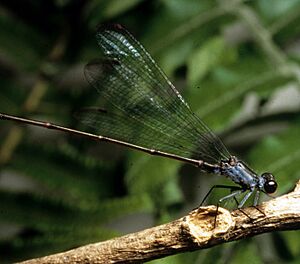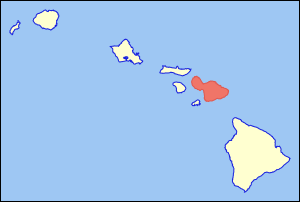Megalagrion nesiotes facts for kids
Quick facts for kids Megalagrion nesiotes |
|
|---|---|
 |
|
| Conservation status | |
| Scientific classification | |
 |
|
| The island of Maui |
The Megalagrion nesiotes is a type of damselfly. Its common name is the flying earwig Hawaiian damselfly. This name comes from its special pincer-like parts on its tail. In the past, these damselflies lived on the islands of Hawaii and Maui. Both islands are part of the U.S. state of Hawaii.
Today, there is only one group of these damselflies left. They live in eastern Maui. Because there are so few of them, they are in danger. They can easily lose their homes or be harmed by new animals. The last time anyone saw a flying earwig Hawaiian damselfly was in 2005. Not much is known about them because they are so hard to find. In 2010, the United States government officially listed this damselfly as an endangered species. This means it gets special protection.
What Does It Look Like?
Adult damselflies have thin bodies. When they rest, their wings fold flat along their bodies. The flying earwig Hawaiian damselfly is bigger than other damselflies. It is also longer.
Adults are usually about 46 to 50 millimeters (1.8 to 1.9 inches) long. Their wings can spread up to 50 to 53 millimeters (1.9 to 2.1 inches) wide. Male damselflies are blue and black. They have large, pincer-like parts on their tails. These parts are called cerci. They look a lot like the pincers on an earwig, which is why the damselfly has its common name. Female damselflies are mostly brownish. The wings of both males and females are clear. Only the tips of their wings are dark.
Scientists have not yet found any young flying earwig Hawaiian damselflies. So, we don't know what they look like directly.
Life Cycle and Reproduction
We don't know much about the life cycle of the flying earwig Hawaiian damselfly. Scientists think it is similar to other narrow-winged damselflies. This is because they are all in the same family, Coenagrionidae. So, some of the information below comes from studying other damselflies in this family.
The Flying Earwig Hawaiian Damselfly
The flying earwig Hawaiian damselfly grows through three stages. These stages are the egg, the young larva (called a naiad), and the adult. This type of growth is called hemimetabolous.
Adult flying earwig Hawaiian damselflies are not strong flyers. They usually stay on thick plants. They fly low to the ground. Female damselflies might lay their eggs on wet ground. They could also lay them in fallen leaves near wet spots. No one has ever seen the young naiads. But scientists believe that these naiads live on land or partly on land. This is different from many other damselflies that live only in water. These naiads might live in damp leaf litter. They could also live in moist soil or wet areas.
General Damselfly Life Cycle
Many female damselflies can lay more than one group of eggs in their lives. Each time, they can lay thousands of eggs. But most of the eggs and young naiads do not survive. Sometimes, only 0-3% of eggs grow into adults.
Damselflies usually lay eggs in late spring and summer. They might lay eggs on plants that are under water. It takes about ten days for the eggs to hatch. Most young Hawaiian damselflies live in water. They hunt and eat other small water creatures or fish. They have three flat gills on their tails to help them breathe.
Young damselflies grow by shedding their skin. This is called molting. They might molt 5 to 15 times as they get bigger. After several months, they become adults. Then, they leave the water and grow wings. They live for a few weeks to several months. During this time, they stay near water and lay their own eggs.
However, a few damselfly species, like the flying earwig Hawaiian damselfly, have young that live on land. These young are usually found in moist, leafy places on the ground. They have short, thick, and hairy gills. They cannot swim. We still need to learn more about these special land-dwelling young.
How They Live
What They Eat
Scientists believe that flying earwig Hawaiian damselflies are predators. This means they hunt and eat other creatures. Based on what other narrow-winged damselflies eat, scientists think adult flying earwig Hawaiian damselflies eat small insects. These include flies, mosquitoes, and moths. Their young, the naiads, likely eat water insects like mosquito larvae.
Behavior
Scientists have not seen much of the flying earwig Hawaiian damselfly's behavior. But we can guess some things based on other damselfly species. When damselflies mate, the male grabs the female with his tail parts. They form a shape called a "tandem." This helps the male protect his mate from other males. When females lay eggs, the males often guard their home areas.
The flying earwig Hawaiian damselfly likely lays eggs in fallen leaves or damp ground near streams. We don't have direct observations of their young's behavior.
When adult damselflies fly and hunt, they use their spiny legs. They form a basket to catch their prey. For insects, they often sit and then pounce on their food.
Flying earwig Hawaiian damselfly adults fly low near their homes. They are not strong flyers. They prefer to sit among plants. If they are disturbed, they might fly downwards. This is different from water damselflies, which fly up and away.
Where They Live
Adult flying earwig Hawaiian damselflies like moist places. These include wet ridges, forest floors, and steep, fern-covered damp banks. Scientists believe their young live on land or partly on land. But no one has ever seen or found them. These young might live in fallen leaves or in the wet parts of plants near water. They could also live in moist soil between rocks.
Flying earwig Hawaiian damselflies are sensitive to temperature changes. They are not very active on cold and rainy days. They are much more active when the weather is warm and sunny.
Where They Are Found
The flying earwig Hawaiian damselfly used to live on the tropical islands of Hawaii and Maui. But since the 1930s, no one has seen this damselfly on the island of Hawaii. The last time it was seen anywhere was in 2005, on the island of Maui.
Protecting the Species
Population Size
In the past, there were at least seven groups of this damselfly on Hawaii. There were five groups on Maui. Now, there is probably only one group left. This group is in eastern Maui. The last time anyone saw the species was in 2005. We don't know exactly how many damselflies are in this last group.
Past and Current Locations
The flying earwig Hawaiian damselfly used to live on the islands of Hawaii and Maui. On Hawaii, it was found in seven or more places. But it hasn't been seen there for over 80 years. Surveys from 1997 to 2008 in good habitats on Hawaii did not find any. On Maui, it was reported in five places on the windy side of the island. But since the 1930s, it has only been seen in one area. This area is along a stream on the windy side of eastern Maui.
Main Dangers
One of the biggest dangers to this damselfly is losing its home. This happens because of farms and cities growing. Also, climate change can now affect their homes. Changes to streams, like moving water, can harm the plants and animals around them. This can make their home worse.
Animals that are not native to Hawaii are another big danger. Wild pigs, for example, live in the wet forests on Maui. They walk all over the forest floor and lie in wet areas. This destroys local plants. Their waste also helps new, invasive plants grow. On Maui, wild pigs have ruined the fern-filled areas where these damselflies live.
Finally, too many damselflies being collected by people can also harm the population. This is especially true if breeding adults are taken.
Endangered Species Protection
On June 24, 2010, the U.S. Fish and Wildlife Service decided that the flying earwig Hawaiian damselfly was an endangered species. This was done under the Endangered Species Act of 1973. This means the species now gets special protection from the government.
Recovery Plan
There is no final plan just for Megalagrion Nesiotes yet. However, there is a plan for 50 Hawaiian species that was suggested on February 24, 2022. This plan includes goals for three Hawaiian damselfly species, including Megalagrion Nesiotes.
The main goal is to have many healthy groups of these damselflies again. They should be able to survive on their own and have different genes. This will make them stronger.
To help Megalagrion Nesiotes, scientists need to look for them often. They also need to keep watching the groups that are left. Important steps include fixing and protecting their homes. It is urgent to make their numbers bigger and spread them out more. Other plans include raising them in special places and storing their genes. It is also important to control animals that are not native to Hawaii. Working with local governments and groups is also key.
For the species to be less endangered, there need to be at least ten stable groups. Their homes must be protected, and all big dangers must be controlled.
To remove the species from the endangered list completely, scientists need to do surveys for 10 years. They need to see a big increase in the size and spread of the ten groups. Their homes must be good, and there should be very few dangers left.



